Sparkle
SP7200T4 (GeForce4 Ti 4400)
and SP7200T6 (GeForce4 Ti 4600),
ABIT Siluro GF4 Ti 4600
Video Card
|

Contents
- Peculiarities of NVIDIA GeForce4 Ti 4400/4600
based video cards from ABIT, Sparkle
- Information on performance of video cards
of the GeForce4 Ti 4400/4600 class
Theoretical materials and reviews of video cards which concern
functional properties of the NVIDIA GeForce4 Ti GPU
- NVIDIA GeForce4 Ti review
- MSI GF4Ti4600 on NVIDIA
GeForce4 Ti - concerns anisotropic filtering in the 3DMark2001 SE, and new
Advanced Pixel Shader Test from this packet.
- Leadtek WinFast GeForce4
Ti 4600 on NVIDIA GeForce4 Ti 4600 - tests based on the Vulpine GLMark with
anisotropy enabled.
- Gainward PowerPack GeForce4
Ultra/700XP and Ultra/750XP Golden Sample on NVIDIA GeForce4 Ti 4400/4600
- Codecult Code Creatures and Novalogic Comanche4 Benchmark.
- Chaintech A-GF61 SE
on NVIDIA GeForce4 Ti 4600 - dependence of the performance on a CPU speed
(AMD Athlon 750, 1000 MHz, Athlon XP 1250, 1666 MHz; in Serious Sam II, Return
to Castle Wolfenstein).
- Creative 3D Blaster GeForce4
Ti 4400 on NVIDIA GeForce4 Ti 4400 - dependence of the performance on a CPU
speed (Intel Pentium III 1000, Pentium 4 2000, 2200 MHz; in Serious Sam II, Return
to Castle Wolfenstein).
- ASUS V8440 and V8460 on
NVIDIA GeForce4 Ti 4400 and 4600 - dependence of the performance on a CPU
speed (Intel Pentium III 1000, Pentium 4 2000, 2200 MHz, AMD Athlon 750, 1000
MHz, Athlon XP 1250, 1666 MHz; in 3DMark2001 SE).
- ABIT Siluro GF4 Ti on
NVIDIA GeForce4 Ti 4400 - AA operation in the 3DMark2001 SE.
- Palit Daytona GeForce4
Ti 4600 - operation of anisotropy on different platforms based on the 3DMark2001
SE (Game1, Game2).
- Joytech Apollo Bloody
Monster II GeForce4 Ti 4600 - examination of anisotropy on different platforms
on the 3DMark2001 SE (Game3, Game4).
- SUMA Platinum GeForce4
Ti 4400 DVI and GeForce4 Ti 4600 SE - examination of anti-aliasing on different
platforms in 3DMark2001 SE (Game1, Game2).
- Triplex Millennium Silver
GeForce Ti 4600 - examination of anti-aliasing on different platforms in 3DMark2001
SE (Game3, Game4).
- Leadtek WinFast A250LE
64 MBytes and Gainward Powerpack Ultra/650XP 128 MBytes on NVIDIA GeForce4 Ti
4200
- SUMA
Platinum GeForce4 Ti 4200 64 MBytes, GeForce4 Ti 4200 SE 64 MBytes, GeForce4 Ti
4200 SE 128 MBytes - examination of anisotropy in Return to Castle Wolfenstein,
Serious Sam: The Second Encounter.
Today we will speak about companies which remain in the shadow
to some reason. For example, ABIT: on the one hand, this is a well-known company
which has been conquering the video card market for 1.5 years already, on the
other hand, its products are not very popular among customers. However, the tests
show that the ABIT's accelerators do not differ much in quality and reliability
from, for example, ASUS or Leadtek... At the same time, they are much less expensive.
It concerns Sparkle as well. This company seems to be an outcast and its products
often sell as noname solutions. But we already tested some cards of this company
and made sure that Sparkle doesn't deserve such treatment.
Today we will examine video cards based on the most powerful
GPUs for today which are NVIDIA GeForce4 Ti 4400/4600, from the companies mentioned
above. All of them are based on the reference design, that is why there is no
differences. However, there is one interesting thing, first of all, it concerns
the Sparkle cards - the lowest price for today!
Cards
All cards have an AGP x2/x4 interface, 128 DDR SGRAM located
in 8 chips on both sides of the PCB.
| Sparkle SP7200T4 (GeForce4 Ti 4400) |

|
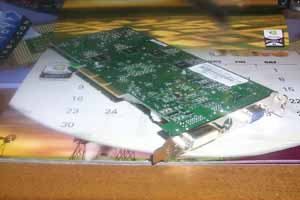
|
| Sparkle SP7200T6 (GeForce4 Ti 4600) |

|

|
| ABIT Siluro GF4 Ti 4600 |

|

|
| Sparkle SP7200T4 (GeForce4 Ti 4400) |
| This card comes with Samsung memory modules of 3.6ns access time
which corresponds to 275 (550) MHz. The memory works this frequency. The GPU operates
at 275 MHz, which is typical of the Ti 4400. |

|
| Sparkle SP7200T6 (GeForce4 Ti 4600) |
| This card comes with Samsung memory modules of 2.8ns access time
which corresponds to 357 (714) MHz. The card works at 300/325 (650) MHz, which
are rated frequencies for the Ti 4600. |
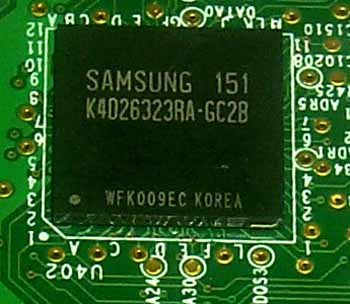
|
| ABIT Siluro GF4 Ti 4600 |
| This card comes with Samsung memory modules of 2.8ns access time
which corresponds to 357 (714) MHz. The card works at 300/325 (650) MHz, which
are rated frequencies for the Ti 4600. |

|
| Comparison with the reference design, front view |
| Sparkle SP7200T4 (GeForce4 Ti 4400) |
Reference card NVIDIA GeForce4 Ti 4400 |

|

|
| Sparkle SP7200T6 (GeForce4 Ti 4600) |
Reference card NVIDIA GeForce4 Ti 4600 |

|
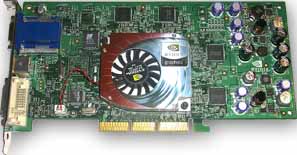
|
| ABIT Siluro GF4 Ti 4600 |
Reference card NVIDIA GeForce4 Ti 4600 |
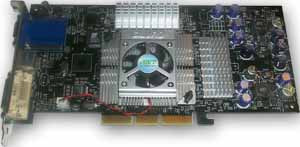
|

|
| Comparison with the reference design, back view |
| Sparkle SP7200T4 (GeForce4 Ti 4400) |
Reference card NVIDIA GeForce4 Ti 4400 |

|

|
| Sparkle SP7200T6 (GeForce4 Ti 4600) |
Reference card NVIDIA GeForce4 Ti 4600 |
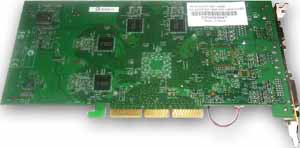
|

|
| ABIT Siluro GF4 Ti 4600 |
Reference card NVIDIA GeForce4 Ti 4600 |
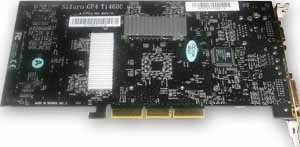
|

|
All three cards correspond to the reference design. The ABIT's
card has only a black PCB. And the Sparkle cards have VIVO (Video-In, Video-Out)
based on the Philips 7108 codec, and are inexpensive.

The ABIT's card has only a TV-out.
Of course, cooling devices are the most remarkable elements
on the modern cards.
| Sparkle SP7200T4 (GeForce4 Ti 4400) / Sparkle SP7200T6
(GeForce4 Ti 4600) |
| As you can see, there are standard coolers recommended
by NVIDIA for such cards. |

|
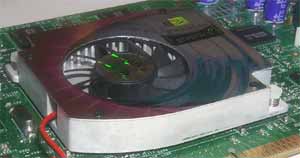
|
| ABIT Siluro GF4 Ti 4600 |
| ABIT keeps its traditions, and as usual it installs
the same cooler you could see on all its cards for 1.5 years already. Besides,
the memory chips are covered with heatsinks, which is also typical of ABIT :-). |

|

|
All cards have DVI and d-Sub connectors unsoldered. Two CRT
monitors can be connected through DVI-to-VGA adapters, which are included into
the packages.
Quality of operation of the TV-out and VIVO was estimated earlier
in our reviews (see the list above).
Now let's take a look at the accessories.
| Sparkle SP7200T4 (GeForce4 Ti 4400) / Sparkle SP7200T6
(GeForce4 Ti 4600) |
| User manual (booklet), CD with drivers and utilities, CD with
CyberLink PowerDirector (for Video-In), DVI-to-VGA adapter, adapter-splitter for
VIVO, S-Video extender. |

|
| ABIT Siluro GF4 Ti 4600 |
| User manual (booklet), CD with drivers and utilities, CD with
NVIDIA demo programs: Experience CD, DVI-to-VGA adapter, S-Video-to-RCA adapter,
S-Video and RCA extenders. |
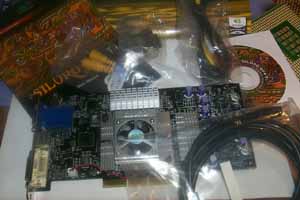
|
All cards ship in retail packages.
| Sparkle SP7200T4 (GeForce4 Ti 4400) |
| The package has a design recommended by NVIDIA, unfortunately,
nothing is said about VIVO. |
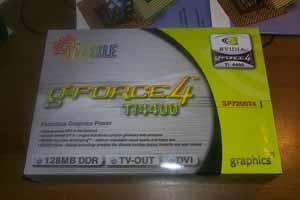
|
| Sparkle SP7200T6 (GeForce4 Ti 4600) |
| The box doesn't differ from the previous one (except the words). |
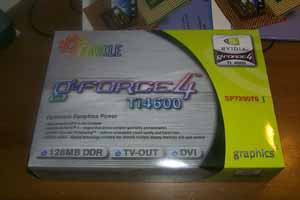
|
| ABIT Siluro GF4 Ti 4600 |
| The design is typical of ABIT with a peculiar pattern. |

|
Overclocking
| Sparkle SP7200T4 (GeForce4 Ti 4400) |
275/550 -> 300/652 MHz |
| Sparkle SP7200T6 (GeForce4 Ti 4600) |
300/650 -> 325/730 MHz |
| ABIT Siluro GF4 Ti 4600 |
300/650 -> 310/750 MHz |
As you can see, the Sparkle cards have scored excellent results,
while the ABIT's solution is more modest.
Note:
- in course of overclocking you must provide additional cooling, in particular,
for the card (first of all, for its memory):

- overclocking depends on a definite sample, and you shouldn't generalize the
results of one card to all video cards of this mark or series. The overclocking
results are not the obligatory characteristics of a video card.
Test system and drivers
Taking into account that we have already studied all peculiarities
of operation of the NVIDIA GeForce4 Ti 4400/4600, there is no need to repeat them
again. Besides, our 3Digest
widely covers performance of such cards in comparison with many others.
Testbeds:
- Pentium 4 2200 MHz based computer:
- Intel Pentium 4 2200 (L2=512K);
- ASUS P4T-E (i850) mainboard;
- 512 MBytes RDRAM PC800;
- Quantum FB AS 20 GBytes;
- Windows XP.
- Athlon XP 1666 MHz (2000+) based computer:
- AMD Athlon XP 2000+
- EPoX 8KHA+ (VIA KT266A);
- 512 MBytes DDR SDRAM PC2100;
- Fujutsu 20 GBytes;
- Windows XP.
The test system was coupled with ViewSonic P810 (21") and ViewSonic
P817 (21") monitors.
In the tests we used NVIDIA's drivers of v29.20. VSync was
off, S3TC was off.
Test results
Before we start examining 2D quality I should say that there
is no a complete technique of objective estimation of this parameter because:
- Almost all modern 3D accelerators can have 2D quality much dependent on a
certain sample, and it's impossible to trace all cards;
- 2D quality depends not only on a video card, but also on a monitor and a
cable;
- Besides, certain monitors do not get along with certain video cards.
As for the tested samples, together with the ViewSonic P817
monitor and BNC Bargo cable the Sparkle cards showed excellent quality
at 1600x1200x85 Hz and 1280x1024x100 Hz. And the ABIT's card demonstrated poorer
quality at 1600x1200x85 Hz.
For estimation of 3D performance we used:
- Return to Castle Wolfenstein (MultiPlayer) (id Software/Activision) - OpenGL,
multitexturing, Checkpoint-demo,
test settings - maximum, S3TC OFF, the configurations can be downloaded
from here
Test order: enable the console with the '~' button and type:
timedemo 1 (press Enter)
demo checkpoint (press Enter)
- 3DMark2001 SE Pro (MadOnion/Remedy), Game2 "Dragothic" - DirectX 8.0, Hardware
TCL, multitexturing, LOW Details, DXTC OFF, double buffering, 24-bit Z-buffer
Test order:
through the 3DMark2001 menu of settings using the Batch
mode
- Serious Sam: The Second Encounter v.1.05 (Croteam/GodGames) - OpenGL, multitexturing,
Grand Cathedral demo, test settings: quality, S3TC OFF
Test order: enable the console with the '~' button and type:
dem_bProfile=1 (press Enter)
start up Grand Cathedral demo from the menu
- Quake3 Arena v.1.17 (id Software/Activision) - OpenGL, multitexturing, Quaver,
test settings are maximum: detail level - High, texture detailing level - #4,
S3TC OFF, smoothness of curved surfaces is greatly increased with variables
r_subdivisions "1" and r_lodCurveError "30000" (at default r_lodCurveError
is 250 !), the configurations can be downloaded from here
- 3DMark2001 Pro (MadOnion/Remedy) - DirectX 8.0, Hardware TCL, Game1, Game2,
Game3, Game4, Low, High detail levels
- Comanche4 Benchmark Demo (NovaLogic) - Direct3D, Shaders, Hardware T&L,
Dot3, cube texturing, highest quality
Test order: start up the game the following way:
c4demo.exe /advbench fps.txt 1024 32 noaudio nct dx7
(press Enter)
- RightMark Video Analyzer v.0.3.2 (Philip
Gerasimov) - DirectX 8.1, Dot3, cube texturing, shadow buffers, vertex and
pixel shaders (1.1, 1.4).
test settings: pixel shaders 1.1, shadow buffers OFF.
The overclocked cards are marked with red color, the sign
o/c (overclocked) is followed by the frequencies reached.
- 1. Return to Castle Wolfenstein - maximum quality settings
- 2. Quake3, QUAVER, - maximum settings
- 3. Comanche4
- 4. 3DMark2001, Game2 Low Details (Dragothic)
- Windows
ME
- Tests
on Athlon
XP 2000+ (1666 MHz),
1024x768
- Tests
on Athlon
XP 2000+ (1666 MHz),
1280x1024
- Tests
on Athlon
XP 2000+ (1666 MHz),
1600x1200
- Tests
on Pentium
4 2200 MHz,
1024x768
- Tests
on Pentium
4 2200 MHz,
1280x1024
- Tests
on Pentium
4 2200 MHz,
1600x1200
- Tests
on Pentium
4 2200 MHz,
800x600, Anti-aliasing
- Tests
on Pentium
4 2200 MHz,
1024x768, Anti-aliasing
- Tests
on Pentium
4 2200 MHz,
1280x1024, Anti-aliasing
- Windows
XP
- Tests
on Athlon
XP 2000+ (1666 MHz),
1024x768
- Tests
on Athlon
XP 2000+ (1666 MHz),
1280x1024
- Tests
on Athlon
XP 2000+ (1666 MHz),
1600x1200
- Tests
on Athlon
XP 2000+ (1666 MHz),
800x600, Anti-aliasing
- Tests
on Athlon
XP 2000+ (1666 MHz),
1024x768, Anti-aliasing
- Tests
on Athlon
XP 2000+ (1666 MHz),
1280x1024, Anti-aliasing
- Tests
on Pentium
4 2200 MHz,
1024x768
- Tests
on Pentium
4 2200 MHz,
1280x1024
- Tests
on Pentium
4 2200 MHz,
1600x1200
- 5. Serious Sam: The Second Encounter
- Windows
ME
- Tests
on Athlon
XP 2000+ (1666 MHz),
1024x768
- Tests
on Athlon
XP 2000+ (1666 MHz),
1280x1024
- Tests
on Athlon
XP 2000+ (1666 MHz),
1600x1200
- Tests
on Pentium
4 2200 MHz,
1024x768
- Tests
on Pentium
4 2200 MHz,
1280x1024
- Tests
on Pentium
4 2200 MHz,
1600x1200
- Tests
on Pentium
4 2200 MHz,
800x600, Anti-aliasing
- Tests
on Pentium
4 2200 MHz,
1024x768, Anti-aliasing
- Tests
on Pentium
4 2200 MHz,
1280x1024, Anti-aliasing
- Windows
XP
- Tests
on Athlon
XP 2000+ (1666 MHz),
1024x768
- Tests
on Athlon
XP 2000+ (1666 MHz),
1280x1024
- Tests
on Athlon
XP 2000+ (1666 MHz),
1600x1200
- Tests
on Athlon
XP 2000+ (1666 MHz),
800x600, Anti-aliasing
- Tests
on Athlon
XP 2000+ (1666 MHz),
1024x768, Anti-aliasing
- Tests
on Athlon
XP 2000+ (1666 MHz),
1280x1024, Anti-aliasing
- Tests
on Pentium
4 2200 MHz,
1024x768
- Tests
on Pentium
4 2200 MHz,
1280x1024
- Tests
on Pentium
4 2200 MHz,
1600x1200
- 6. iXBT RightMark Video Analyzer
Conclusion
I think there's no need to draw conclusions on the performance
results because everything that must be said is said and all the rest can be found
in our 3Digest. But I have something to say about the video cards.
Priced at $230 and $305, the video cards based on the GeForce4
Ti 4400 and Ti 4600 from Sparkle possess excellent price/quality/speed ratios.
Besides, both cards have VIVO!
The ABIT's card looks more modest, but its price is low as
well, that is why it can be a nice purchase for those who can afford such a powerful
accelerator. All the cards in question have impeccable quality, a little worse
2D quality of the y ABIT Siluro GF4 Ti 4600 can be peculiar only to the given
sample. But on the whole, the card leaves a good impression.
Highs:
- Excellent performance in modern 3D games;
- High quality of the tested samples;
- Reference-based design;
- TV-out of the ABIT Siluro GF4 Ti 4600 and VIVO of both Sparkle cards;
- All necessary adapters provided.
Lows:
Write a comment below. No registration needed!
|
|
 |
|
|
|



